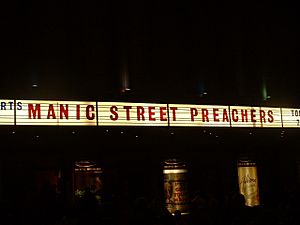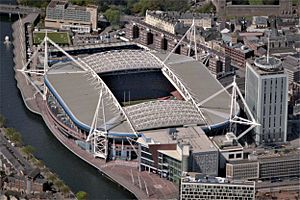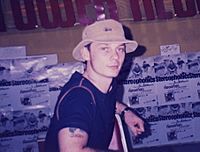Cool Cymru facts for kids
Quick facts for kids Cool Cymru |
|
|---|---|

Manic Street Preachers performing in London. The band were one of the pioneers of the era for Welsh music.
|
|
| Native name |
Cŵl Cymru
|
| Stylistic origins |
|
| Cultural origins | Music of Wales |
| Regional scenes | |
| Music of Wales | |
| Local scenes | |
| Music of Cardiff Music of Newport |
|
| Other topics | |
| Welsh Music Prize Welsh Language Music Day |
|
Cool Cymru (which means "Cool Wales" in Welsh) was an exciting time for Welsh culture in the 1990s and early 2000s. It was a period when Welsh music and independent films became very popular. Bands like Stereophonics, Manic Street Preachers, Catatonia, and Super Furry Animals led this movement.
| Top - 0-9 A B C D E F G H I J K L M N O P Q R S T U V W X Y Z |
What is Cool Cymru?
The name Cool Cymru comes from Cool Britannia. Cool Britannia was a term used to describe a new wave of British art and culture in the 1990s. It focused a lot on London and British symbols like the Union Jack flag.
By 1998, many Welsh artists and cultural figures were becoming famous across the UK. At the same time, some people felt that Cool Britannia was used too much for everything British. So, Cool Cymru became a popular term for things that were specifically Welsh. This term is still used today, even though Cool Britannia is not as common anymore.
Why did Cool Cymru happen?
A New Start for Wales
Some people believe that Cool Cymru happened after a tough time in the UK during the 1970s. Wales, especially the South Wales Valleys, faced economic challenges when coal mines closed. This led to high unemployment and social problems.
However, the 1980s brought new hope. Then, in 1997, the New Labour party, led by Tony Blair, won the election. They promised to give more power to Wales and Scotland. They also connected with popular artists from the Britpop music scene, like Noel Gallagher.
Finding Welsh Identity
Some experts say that Cool Cymru artists wanted to show a new side of Wales. For a long time, Wales was seen as less famous for rock music compared to England. England had global stars like The Beatles and The Rolling Stones.
While Scotland and Northern Ireland had famous punk and indie bands, Wales was sometimes overlooked. This feeling of being "underachievers" pushed artists like Cerys Matthews and Richey Edwards to create unique and rebellious music.
Many other things were happening in Wales in the 1990s too. The Welsh TV channel S4C grew, the National Eisteddfod of Wales (a big cultural festival) got more funding, and new buildings like the Millennium Stadium and the Riverfront Arts Centre in Newport were built. Cardiff Bay was also redeveloped. All these changes helped create a strong sense of Welsh pride.
Wider Welsh Culture
The 1990s was a special time for Wales, with many people gaining international fame. Welsh athletes like Joe Calzaghe (boxing), Ryan Giggs (football), and Scott Gibbs (rugby) were doing great things.
Famous Welsh actors also made their mark. Ioan Gruffudd starred in Solomon & Gaenor, which was nominated for an Academy Award. Rhys Ifans and Anthony Hopkins appeared in August. And Huw Garmon starred in the Oscar-nominated Welsh language film Hedd Wyn.
In 1997, the film House of America was released, about a family in a Welsh mining town. That same year, Newport director Julian Richards made Darklands, the first Welsh horror film. A very popular film from this time was the comedy Twin Town, which is still a cult classic in Swansea.
The Guardian newspaper once described the Cool Cymru scene as a "proud nation" with stars like footballer Ryan Giggs, actress Catherine Zeta-Jones, fashion designer Julien Macdonald, and rappers Goldie Lookin Chain.
Cool Cymru Exhibit
Photographer Terry Morris from Llanelli was close to the events of this era. He took many pictures that documented the decade. His book and exhibition, also called Cool Cymru, were launched at the Wales Millennium Centre. This series later became a three-part TV documentary.
Music Culture
Welsh-ness in Music
One way to look at Welsh music during this time is to see two main types of bands:
Bands that proudly showed their Welsh identity Bands like Super Furry Animals, Gorky's Zygotic Mynci, and Catatonia were very ambitious. They showed their Welsh identity by including Welsh language songs in their music.
Bands that were Welsh but didn't always focus on it In contrast, bands like Manic Street Preachers and Stereophonics focused more on their musical style than their geography. They didn't avoid their Welsh roots, but they also didn't always celebrate them openly. They aimed to be popular beyond Wales.
Stereophonics
Stereophonics released their first album, Word Gets Around, in 1997. They became famous as the first band to sign with Richard Branson's V2 Records. Their album was praised for asking important questions for young people in Wales in the 1990s. For example, in their song Traffic, they sang:
"Is anyone going anywhere?
Everyone’s got to be somewhere."
Stereophonics - "Traffic"
They also sang about youth unemployment:
"I don’t live to work,
I work to live,
I live at the weekend."
Stereophonics - "Last of the Big Time Drinkers"
Writer Griffin Kaye called Stereophonics "proud, unapologetic Welshmen" who helped carry the Cool Cymru sound from one generation to the next.
Super Furry Animals
This group famously reached number 11 in the UK music charts in 2001. This was surprising because their album had ten songs in the Welsh language!
Welsh Music Foundation
Pooh Sticks lead singer Huw Williams helped start the Welsh Music Foundation. This organization, supported by the government, helped make Welsh music more famous both in Wales and around the world. It helped bands like Lostprophets and Mclusky become successful. It also brought BBC Radio 1 to Wales for the first time for a music event in Cardiff.
Is Cool Cymru Back?
With the growth of events like Welsh Language Music Day, Sŵn Festival, and Tafwyl, and many new Welsh musicians, the BBC has wondered if Cool Cymru is making a comeback. Radio presenter Huw Stephens explored this idea in his BBC Radio 4 show, Cymru Rising.
Sport
Colin Jackson
Throughout the 1990s, Colin Jackson was one of Great Britain's most successful athletes in hurdles. He was known for waving the Welsh flag after every win for Great Britain. Jackson later said he became more aware of his Welsh identity because of some negative feelings towards Welsh people during this time.
Jackson's success and pride in being Welsh made him a hero in Wales. He became an early symbol of Cool Cymru. He won BBC Wales Sports Personality of the Year three times and was invited to present an award to the Manic Street Preachers at the 1997 Brit Awards.
Rugby Union
Rugby has always been Wales' national sport. The 1980s and early 1990s were tough times for Welsh rugby. Some star players like Jonathan Davies, Scott Quinnell, and Scott Gibbs left Wales to play Rugby League for more money.
However, during the height of Cool Cymru, rugby union became a professional sport. This allowed Welsh clubs to bring these star players back home. Davies, Quinnell, and Gibbs all returned to play rugby union in Wales and for the national team.
Wales' rugby team started to improve when Graham Henry became coach in 1998. People had high hopes for a Welsh rugby revival. Henry was even called "The great Redeemer," a reference to a famous Welsh hymn. In his first year, Henry led Wales to a record ten straight victories, including a first-ever win against South Africa and a close victory over England at Wembley.
England at Wembley
This match was the last ever Five Nations game and Wales' last home game before the new Millennium Stadium was finished. BBC Wales caused some debate by using a song by Kelly Jones (from Stereophonics) called "As long as We Beat The English" to promote their coverage. The song talked about Wales' recent losses and suggested that beating England would make everyone forget them. Some people thought the song was too aggressive, but others praised it for showing Wales' new pride during the BBC's "year of Cool Cymru." The build-up to the match also featured Welsh legends like Tom Jones and Max Boyce.
England was expected to win easily and complete a Grand Slam (winning all their games). They played better for most of the game, but Wales was only 6 points behind with three minutes left. In Wales' final attack, Scott Quinnell passed to Scott Gibbs. Gibbs famously broke through England's defense, ran around one player, and scored one of the most celebrated tries in Welsh rugby history. Neil Jenkins kicked the conversion, and Wales won by one point! Gibbs's try is still replayed at many events, like Stereophonics concerts.
World Cup and Millennium Stadium

When rugby became a professional sport in 1995, and Wales won the bid to host the 1999 Rugby World Cup, the Welsh Rugby Union could afford to rebuild the old National Stadium. The project cost £121 million and was partly funded by the Millennium Commission, so it was named the Millennium Stadium.
The stadium was finished by June 1999, just in time for the World Cup opening ceremony and seven matches, including the final. This project also led to more redevelopment in Cardiff and Cardiff Bay. Many people see the stadium as one of the most important lasting impacts of the Cool Cymru era. It has helped Cardiff's economy by bringing in £100m-£135m every year since it was built.
Legacy
In 2021, actor Matthew Rhys said he believed Cool Cymru had a positive effect on how the Welsh language was accepted. He hoped to have a similar impact in his own career.
See also
- Cool Britannia
- British Invasion
- Cool Japan
- Korean Wave
- Taiwanese Wave
- Post-Britpop


